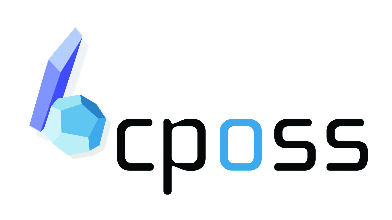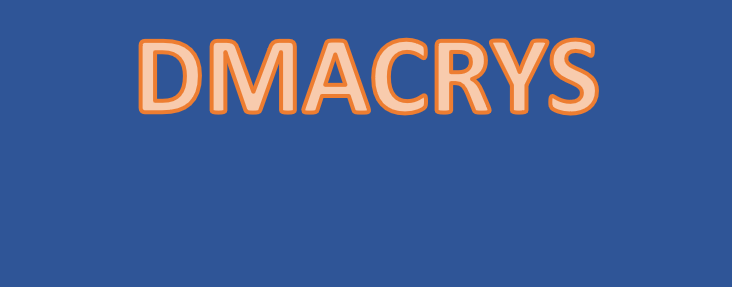




Morphology and Powder Pattern calculation
The computational tools were developed by Dr David S Coombes funded by the E-Science project.
The attachment energies and surface energies for the crystal structures
are calculated using the same repulsion-dispersion potential used in the
search (e.g. fit.pots, unless an anisotropic potential was used, in which
case a corresponding isotropic exp-6 potential must be used) and the potential
derived charges corresponding to the same wavefunction used for the DMA.
The calculated attachment energy morphologies are not very sensitive to
differences in the potential1 and hence this approximation, or ignoring
changes in the charges with minor changes in conformation is adequate
within the errors of the attachment energy model. The potential derived
charges in molecule.pdc have the format in this example 5azauracil.pdc
1 NIT1 -0.747931
2 NIT2 -0.854956
3 NIT3 -0.802677
4 OXY1 -0.566201
5 OXY2 -0.577182
6 CAR1 0.963656
7 CAR2 1.124272
8 CAR3 0.651820
9 HPD1 0.383573
10 HPD2 0.388389
11 HYD3 0.037237
The script ~cposs/bin/pdc2chg.pl (Usage: pdc2chg.pl logfile dmaoutfile
> chargefile) can produce this file from the Gaussian .log file that
does the DMA and calculates the CHELPG potential derived charges and any
dmaout file with the DMAREL atomic types. The atoms must be in the same
order.
The calculations uses the BDFH method (calculated by GDIS) to identify the most important faces, and then MARVIN2 to calculate the surface and attachment energies for these unrelaxed faces. By assuming that the proportionality between attachment energy and growth rate is the same for different crystals of the same molecule, a relative growth rate is also calculated by integration over the crystal volume3. (NB this assumes that there are no visible faces with AE’s of <-99.9 kJ/mol) Note that the quoted growth volumes are only relative, and scaled relative to a cube in which each face has an AE of 5 kJ/mol (i.e. volume is 1000 (kJ/mol)3 ) This information is stored in the structure.gv output file in a format that can be uploaded to the database and portal.
The attachment energy model is based only on the crystallographic symmetry and the interactions between the molecules (i.e. absolutely no reference to solvent, and assumes a growth and spread mechanism below the roughening temperature) and so should be best at predicting the vapour grown morphology when the growth unit is the content of the asymmetric unit of the cell. Hence, comparing results between Z’=1 and other Z’ structures is not really valid and should be done with caution (and with an extended .pdc file). The growth volume and morphology data will therefore not usually be included in the database for symmetry reduced structures.
The other input files are .res (Shelx files). The system can handle either the standard .res files (i.e. C1 type, though note that it currently needs chlorine as Cl etc) or the old style fort.16 outputs of CAR1 etc type. (The automatically discriminates between these file formats) The atomic types handled are C, H, N, O, S, F, Cl, Br and the program will identify HY, HP atomic types. The program will only deal with this set of atomic types. Note that the program uses the DMAREL system and needs to match the CAR3, HPD1 etc with those in the charges file in the same order, and have all the potentials defined as in DMAREL. The *.gin file reveals any problems with the identification of atomic types.
The procedure also uses the input structure file to create a .spf file with the correct space group label, by using http://cci.lbl.gov/cctbx/shelx.html to convert the symmetry cards to the space group label. Since this step can only be performed through internet access, this step may need to be done separately from the bulk of the calculations.
The powder pattern corresponding to a radiation of wavelength of 1.54056 Å, is also calculated using ObjCryst++, as part of the procedure. This result is tabulated in the structure.pp file, for upload to database and dataportal.
Both the calculated morphologies and the powder patterns can be visualised, requiring the files structure.final.gmf for morphologies and .pdf or .svg for powder patterns.
INSTRUCTIONS FOR PERFORMING MORPHOLOGY PROPERTIES CALCULATIONS
- Need the following programs/scripts in the /home/cposs/bin directory:
growth
res2spf.pl, ReadCrystalFiles.pl
shelx2gulp.exe
gulp, libcxa.so.5, libunwind.so.5
gdis, libgtglext-x11-1.0.so.0, libgdkglext-x11-1.0.so.0
morpheus.pl, getopts.pl, marvin_1_linux
growth_volume.exe, sginfo
gulp2dat_split2.pl, fluorine.exe, plotter
Need to edit path for ‘require’ in .pl scripts.
Need to add /home/cposs/bin to user’s path
Also need to have gnuplot installed to produce pdf and svg of powder patterns - In run directory need
Potential file (same format as DMAREL) e.g. pote.dat
Charges file (with 4 atom labels) from Gaussian with atoms in the same order as the .res file. This can be created from a log file and a DMAOUT file using pdc2chg.pl, e.g. molecule.pdc - To Calculate morphology and powder pattern
- Individually on front end
growth $1 $2 $3 $4
$1=name of structure
$2 type (res or 16 or spf)
$3 potential
$4 charges
e.g. growth ab15 res pote.dat molecule.pdc - A whole set of structures in one directory, submitting the majority
of the work to the Xenon queue
./Create_spf
to provide the .spf file for each structure in same directory.
Then submit the job by
qsub growth_volume_dir.csh which invokes growth_volume_dir to loop over the jobs and do growth on each. These files in the same directory as all the .res and .spf files. - To run the set of files in the unique_pool structure created
by the analysis/clustering/properties sequence.
Ensure that pote.dat and molecule.pdc, stable_list_clus and are all in the directory, along with copies of. create_spf_v1.0, growth_volume_v1.0 and growth from cposs/bin.
Run ./ create_spf_v1.0 on front end to generate the .spf files in unique_pool/ab/92_1 etc
Then qsub growth_volume.csh to submit job to Xenon nodes. This invokes growth_volume_v1.0 to use stable_list_clus to select only those structures that are not symmetry reduced for calculation using growth. (Want adaptation so that it also does just the powder patterns for SE symmetry reduced structures incorporating scripts below). - To just get a single powder pattern run, for example for symmetry
reduced structures
Need powder_pattern.sh and res2dat.pl in same directory as structure.res file (currently in slp/chlorothalonil/fromHf/growthvol/powderonly)
./powder_pattern.sh structure
- Individually on front end
VISUALISATION for morphologies
This can be done using the PC version of GDIS which can be downloaded
from ftp://ftp.seul.org/pub/gdis/
(It appears that this program has to locate files to load from C drive).
If you load the structure.final.gmf you will display the predicted morphology
from the AE model, with the faces labelled, and be able to rotate it.
If you load the .cif or .res file, then you can picture the unit cell
content and faces (How can David give us some instructions?? Further instructions
can be found on…)
From Xenon
This is currently only available on Alston’s Linux PC or PC’s
with Exceed-3D.
You need structure.final.gmf file.
Logon to Xenon
ssh –X slp@xenon.chem.ucl.ac.uk
setenv LD_LIBRARY_PATH /home/cposs/bin
gdis
Then type open and browse to find the .gmf file.
STORAGE for DATABASE and DATAPORTAL
For upload to database, need
REFCODE_gv containing set of files REFCODE_conf_ab15.gv
REFCODE_pp containing set of files REFCODE_conf_ab15.pp
The Aspect Ratio is not yet programmed in, and there are still formatting problems with reading in the powder pattern.
In addition, for upload to dataportal desire to keep all morphology &
powder pattern files together, hence
REFCODE_gv containing structure_final.out to give all symmetry related
faces and calculated energies
containing structure_final.gmf for visualisation
containing structure.mvn for Marvin input files
REFCODE_pp containing the structure.pdf files as pictures of powder patterns
containing structure.svg so that powder pattern can be viewed in internetexplorer
and paintshoppro.
Reference List
1. M. Brunsteiner and S. L. Price, Cryst. Growth Des., 2001, 1, 447-453.
2. D. H. Gay and A. L. Rohl, J. Chem. Soc. Faraday T., 1995, 91, 925-936.
3. D. S. Coombes, C. R. A. Catlow, J. D. Gale, A. L. Rohl, and S. L. Price,
Cryst. Growth Des., 2005, 5, 879-885.
© UCL Chemistry Department 2022. This page was last updated on 17 August, 2022. If you have any problems with this page please email the WebMaster